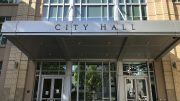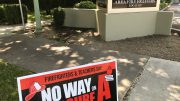Editor’s note: “Defund the Police” has momentum. But what if cutting the Sacramento police budget means more crimes go unsolved?
When the Sacramento City Council convenes a high-stakes debate on police reform this week, it will hear from activists, community leaders and perhaps relatives of people killed by the police.
There’s another group that also deserves to be considered—the victims of homicides and other serious crimes that remain unsolved.
Their voices, and those of their families, are noticeably missing from the conversation so far, as almost everyone jumps on board the “Defund the Police” bandwagon, at least partly.
Activists want to drastically reduce the Police Department budget and spend the money instead on community development, youth programs and social services to help prevent crime and make neighborhoods safer—without police officers.
Mayor Darrell Steinberg and others want to divert a smaller amount of money from the department to a new civilian unit that would handle 911 calls that involve homeless and mentally ill individuals.
But what if cutting the police budget would make it even more difficult to meet one of its primary duties—to investigate and solve crimes?
It turns out that Sacramento’s police department is already below average compared to other law enforcement agencies in California.
Between 2009 and 2019, Sacramento’s clearance rate for violent crimes was never better than 43%, according to the state Department of Justice. It was 40% in 2019, when it made arrests in 1,301 of 3,223 violent crimes.
Statewide in those same years, the clearance rate for violent crimes ranged from 43% to 47% and was 46% in 2019.
For homicides, Sacramento had a 58% clearance rate in 2018 and 88% rate in 2019, compared to the 64% clearance rate statewide in 2018 and 65% in 2019.
For rapes, Sacramento police solved 33% in 2019, compared to 36% for all California agencies, which is why the push to reduce the backlog of untested rape kits is so important.
But for property crimes, the Sacramento department is doing worse, clearing a high of 14% in 2010 and a low of 6% in 2019. The statewide rates ranged from 14% to a low of 10% in 2018 and 11% in 2019, according to the numbers compiled by the state.
Nationally, 62% of homicides and 34% of rapes were cleared in 2017, according to the FBI.
It’s important to note: Black people make up a disproportionate number of homicide victims—and their cases are less likely to be solved. An exhaustive analysis published by The Washington Post in July 2018 found that during the previous decade in 52 large cities, 18,600 of the 26,000 victims were Black. But only 47% of their cases ended in arrest, compared to 63% of cases with white victims.
In Sacramento, a significant share of violent crime is in predominantly Black neighborhoods. On June 23, the police department issued a community alert about a spike of shootings since late May—a total of 17 resulting in at least 30 victims, including nine shootings resulting in homicides.
“We have a lot of victims out there,” said Nina Salarno Besselman, president of Crime Victims United, a statewide advocacy group based in Auburn. Besselman, whose sister was murdered in 1979, opposes defunding police, which she says will create more victims.
There is intense coverage of Joseph James DeAngelo, the “Golden State Killer,” who is pleading guilty Monday to 13 murders in six counties to avoid the death penalty. His arrest, through DNA and a genealogical website, came more than 40 years after the first crime.
But as Besselman points out, for every high-profile case like that, there are hundreds and hundreds of murderers and rapists out there, going unpunished for what they did to their victims.
“These families deserve to have some peace brought to them as well,” she said.
There are hundreds and hundreds of murderers and rapists out there, going unpunished for what they did to their victims. “These families deserve to have some peace brought to them as well.”
Nina Salarno Besselman, president of Crime Victims United
The spotlight is on victims of police killings, and for very good reasons. The police reform debate and the broader reckoning on race is different this time, after the death of George Floyd in Minneapolis on Memorial Day.
Huge multi-ethnic protests happened in small towns and big cities across America. Statues of racially controversial figures are coming down. The Confederate emblem is being removed from the Mississippi state flag and banned from NASCAR races. Household brands, major buildings and well-known bands are changing their names.
With Congress still stuck in partisan gridlock on policing changes, the action is happening locally. On June 26, the Minneapolis council voted to eliminate the police department entirely, asking voters to approve a new department of community safety and violence prevention with a much smaller law enforcement division.
At this point, Sacramento officials aren’t considering anything so drastic.
Tuesday, the City Council updated a use-of-force policy that was unanimously approved in November 2016. Council members Angelique Ashby and Larry Carr put forward the proposal to ban officers from using chokeholds and no-knock warrants and to require training of officers in explicit and implicit racial bias.
At Wednesday’s special meeting, the council will take up the mayor’s proposals, including an independent inspector general to investigate police shootings and the new 911 team.
UPDATE: The agenda also includes proposals from council members, including ones from Councilman Allen Warren to improve community relations and increase transparency by having all officers hand out business cards with their name, badge number and an 800 number for feedback.
The agenda also includes an update on the Advance Peace program to prevent gang violence, which has had early success; and a proposal to support a bill by Assemblyman Kevin McCarty of Sacramento to create a unit within the state Attorney General’s office to investigate police shootings.
But the debate here is focusing intently on the money. Unless the City Council changes its previous votes, the police department budget for 2020-21, the fiscal year that starts Wednesday, will increase by about $10 million to $157 million.
Police Chief Daniel Hahn opposes defunding, but he does support some activists’ demands—such as training officers in deescalation techniques and recruiting a more diverse department—that could add costs, at least in the short run.
But what if deeper funding cuts lead to even more unsolved crimes? Shouldn’t those victims and their families get justice, too?






Sorry, Foon, but that is some fuzzy thinking. Since the Sac police are inefficient in solving crime, we should continue to fund them to be inefficient in solving crime? And though some people are urging complete defunding, most people are urging removal from police responsibility of interactions that allow and promote racial profiling. Investigations could be done by many different people; it is not logically a function of armed police.
Throwing good money after bad is not a solution, and will not alter outcomes. Change is required. Imagine if mental health responders arrived instead or (or with) police during mental health emergencies. Imagine that taking reports of theft was completed by trained city workers not wearing a gun. Imagine if homeless calls were met by trained social workers working with police. Imagine that instead of patrol officers driving around punching license plates into their computer looking for people to pull over, they were actually investigating crimes. All of this can happen by diverting funds from police to other types of responders. The data is pretty clear that poor areas of the city are over policed in ways that do not solve actual crimes.
Why not remove all police presence from areas that the protestors and sloganeers inhabit? Perhaps the people can peacefully coexist without outside interference. Separation is good. HM
an ounce of prevention is worth a pound of cure.